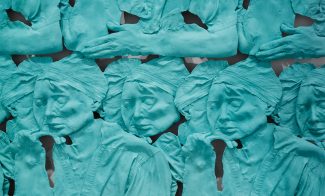Trained as a painter, Lucy Kim has developed a robust body of work situated between meticulous image-making and low-relief sculpture, to explore the sometimes uncomfortable spaces between the natural and artificial.
Kim’s painted wall sculpture, Dr. Melissa Doft, Plastic Surgeon 1 is the first in an ambitious recent series that captures the features of three people whose work alters the human body: plastic surgeon Melissa Doft (the subject of this work); Kim’s personal trainer, Stephen Marino; and Eric. S. Lander, a geneticist, molecular biologist, mathematician, and director of the Broad Institute of MIT and Harvard. After meeting Dr. Doft—a highly successful plastic surgeon based on New York’s Upper East Side, and collector of Kim’s works—the artist became interested in occupations that shift cultural perceptions of the body through its manipulation. Updating age-old ceremonial and artistic processes, her method involves a painstaking sequence of steps in which she casts a mold of the subject’s torso and face, uses Photoshop to create a surface pattern, and then constructs and paints the final work. These so-called “life masks” register an uncanny transitional state, lifelike yet frozen, unique yet multiplied, distorted yet descriptive. Drawing on traditions of religious and ceremonial sculpture, low-relief architecture statuary, and trompe l’oeil painting, these works hover between painting and sculpture, between image and object. By indirectly manipulating the body of each of her subjects, Kim creates an unsettling meditation on our fragile, mutable physical states.
Lucy Kim was included in the 2017 James and Audrey Foster Prize exhibition at the ICA/Boston, where this series made its debut. Additionally, Kim’s painted sculpture is in dialogue with a number of works in the museum’s collection—such as those by Louise Bourgeois, Dana Schutz, Mona Hatoum, Ellen Gallagher, and others—that visually modify parts of the body to probe social and cultural questions.
2017.02

